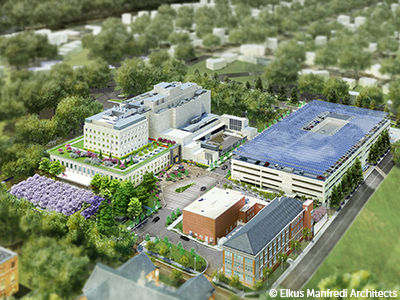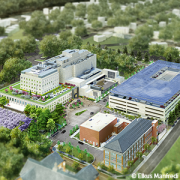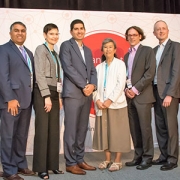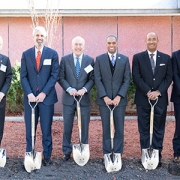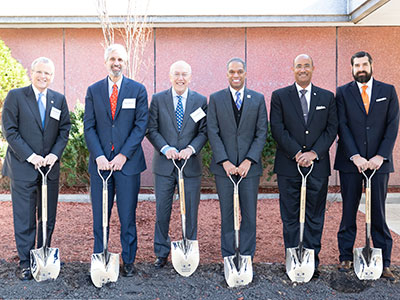
The event featured an onstage discussion by Melinda Richter, global head of Johnson & Johnson Innovation – JLABS and Dr. Kurt Newman, M.D., president and CEO of Children’s National Hospital, about the power of collaboration to spur innovation.
The 7th Annual Pediatric Device Innovation Symposium, presented by Children’s National Hospital, recently brought together stakeholders from across the clinical, investor, business and regulatory sectors of pediatric device development for a day-long program focused on closing the wide gap that exists between the number of medical devices developed for adults and the significantly smaller number developed for children.
Co-located with AdvaMed’s The MedTech Conference for the third consecutive year, the symposium featured an opening keynote address by Melinda Richter, global head of Johnson & Johnson Innovation – JLABS, who was later joined Kurt Newman, M.D., president and CEO of Children’s National Hospital, for an on-stage discussion about the power of collaboration to spur innovation.
That collaboration was on display as Dr. Newman and Richter shared details of the recently announced JLABS @ Washington, DC, a 32,000 square-foot facility to be located at the new Children’s National Research & Innovation Campus on the former Walter Reed Army Medical Center campus in the nation’s capital.
“We had this idea at Children’s National to develop the first pediatric research and innovation campus in the world to create a sustainable pipeline and ecosystem of everything needed to bring medical devices from concept to market for children. Seeing what Johnson & Johnson has accomplished with JLABS across the world, we knew they were the right partner,” said Dr. Newman.
Richter highlighted the need to take action, “We have made modest progress in pediatric device innovation, but we need to do better. We need to advance solutions that take into account the unique characteristics of our youngest and most vulnerable of patients. Only then will we achieve real progress for children and their families.” Of all the medical devices approved each year, only 25% are approved for children and most of those are approved for patients over the age of 18. Richter encouraged symposium attendees to leverage collaborations and convenings to move pediatric device development forward and lauded innovators focused on babies and children, calling them “super heroes.”
$150K medical device pitch competition

Six innovations that address the significant unmet needs of neonatal intensive care unit (NICU) patients were awarded a total of $150K during the medical device pitch competition at the 7th Annual Pediatric Device Innovation Symposium hosted by Children’s National Hospital at Boston Convention & Exhibition Center. From L to R are: Anthony Sandler, M.D., Children’s National Hospital; Neil Ray, Raydiant Oximetry; Julia Finkel, M.D., AlgometRx, Inc.; Eric Chehab, Ph.D., Novonate; Xina Quan, Ph.D., PyrAmes, Inc.; Mark Lehmkuhle, Epitel, Inc.; Adam Zysk, Ph.D., Rhaeos, Inc.; and Kolaleh Eskandanian, Ph.D., Children’s National Hospital.
Six winners were announced in the symposium’s $150,000 “Make Your Medical Device Pitch for Kids!” competition, sponsored by the National Capital Consortium for Pediatric Device Innovation (NCC-PDI) and focused on NICU devices, which the FDA identifies as an area of significant need for innovation. Ten finalists presented their innovations for a panel of 25 expert judges. Each winner receives a $25,000 award and an opportunity to participate in a first-of-its-kind pediatric accelerator program led by MedTech Innovator.
The winning pediatric devices and companies are:
- AlgometRx, Inc., Washington, D.C. – The AlgometRx Rapid Drug Test is used to detect and monitor neonatal abstinence syndrome, allowing for earlier assessment and intervention of opioid withdrawal to reduce physiological stress.
- Epitel, Salt Lake City, Utah – Epilog is an inexpensive, discrete and disposable EEG machine that provides real-time monitoring to revolutionize the way neonates suspected of hypoxic-ischemic encephalopathy are managed at community hospitals.
- Novonate, South San Francisco, Calif. – LifeBubble secures and protects the umbilical catheter insertion site for neonates in intensive care, preventing infection from caregivers and parents.
- PyrAmes Inc., Cupertino, Calif. – Noninvasive and wireless, the Boppli Band allows for risk- and pain-free continuous blood pressure monitoring for neonates.
- Raydiant Oximetry, Mountain View, Calif. – Raydiant Oximetry Sensing Systems is a novel, non-invasive technology that more accurately detects fetal distress during labor and delivery, reducing medically unnecessary cesarean deliveries and the occurrence of newborns suffering the consequences of metabolic acidosis.
- Rhaeos, Inc., Evanston, Ill. – FlowSense is a wearable device that enables noninvasive monitoring of ventricular shunt function in patients who have hydrocephalus, obviating the need for imaging and unnecessary hospital visits and admissions.
“Improved neonatal monitoring devices, such as those among our award winners, can make a critical difference in detecting interventions that could positively impact the long-term developmental trajectory of many children, said Kolaleh Eskandanian, Ph.D., M.B.A., P.M.P., vice president and chief innovation officer at Children’s National and principal investigator of NCC-PDI. “We welcome these winning companies into the NCC-PDI network of device startups and entrepreneurs and look forward to helping them accelerate commercialization so that these innovations can benefit children everywhere as soon as possible.”
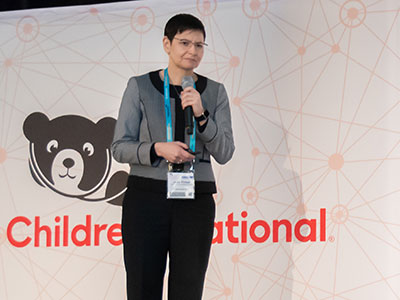
Children’s National anesthesiologist and innovator Julia Finkel, M.D., delivers a winning pitch for her AlgometRx device for detecting and monitoring neonatal abstinence syndrome.
Award-winner AlgometRx is a spinout company from Children’s National Hospital that was founded by anesthesiologist and pain medicine research chief Julia Finkel, M.D. A non-invasive, handheld and portable device, AlgometRx captures a digital image of a patient’s pupillary light response and applies a series of propriety algorithms to measure pain type, intensity and drug effects in real time. Designed for use in virtually any clinical setting, Dr. Finkel originally developed this objective pain measurement technology to aid in diagnosing and monitoring non-verbal pediatric patients such as neonates. AlgometRx was also selected earlier this year to join the JLABS location in Philadelphia.
This is the ninth pediatric medical device competition sponsored by NCC-PDI, one of five FDA-funded programs focused on addressing unmet needs for pediatric medical devices. The consortium is led by the Sheikh Zayed Institute for Pediatric Surgical Innovation at Children’s National Hospital and the A. James Clark School of Engineering at the University of Maryland. NCC-PDI recently added new accelerators BioHealth Innovation and MedTech Innovator and design firm partner, Archimedic.
The symposium also featured four multidisciplinary panel discussions that followed the theme “Pediatric Device Clinical Trials: Forging a Better Path.” Solutions uncovered during these panels will be highlighted in an upcoming whitepaper that will be used to suggest FDA guidance on pediatric device trial conduct and best practices to safely validate medical devices for children more efficiently and effectively.
Vasum Peiris, M.D., chief medical officer, Pediatrics and Special Populations, Center for Devices and Radiological Health, FDA, gave the closing address, which outlined FDA initiatives focused on pediatric device development. David L. Wessel, M.D., senior vice president for the Center for Hospital-Based Specialties at Children’s National, provided an insightful overview of why NICU device development is so important and shared some of the NICU innovations currently in development at Children’s National, which ranks #1 nationally in NICU care.
